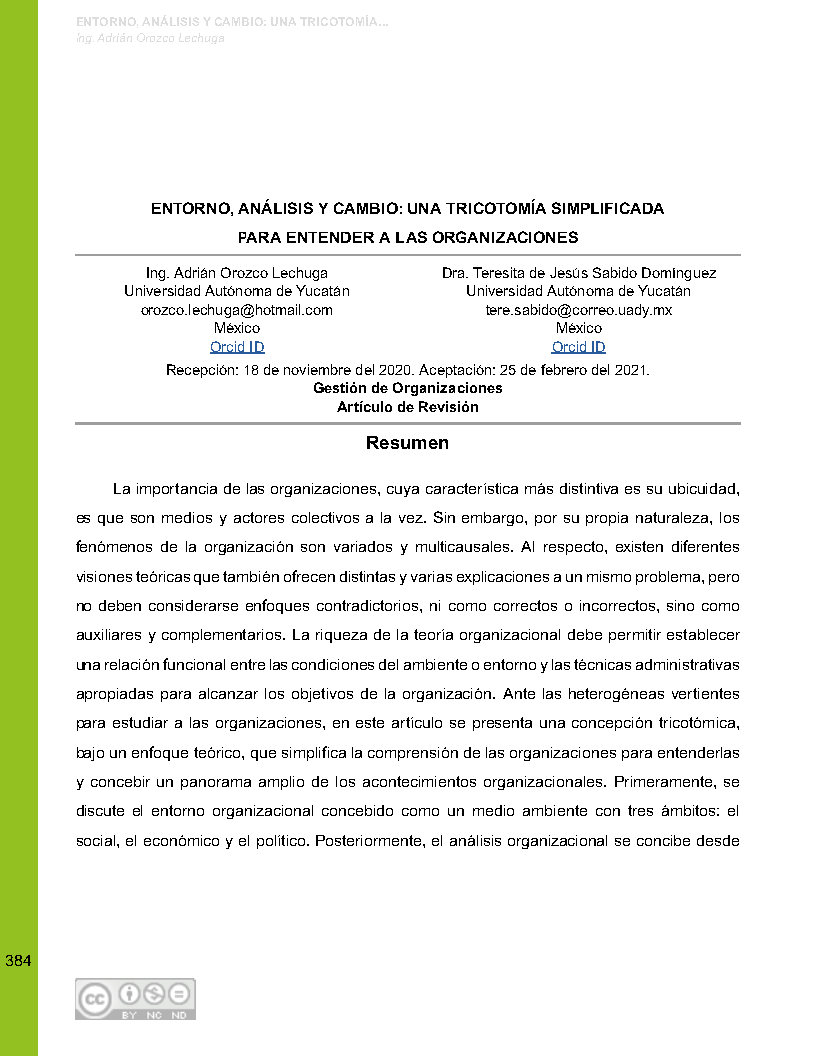Environment, analysis, and change: a simplified trichotomy for understanding organizations
Keywords:
Organizations, organizational environment, organizational analysis, organizational change, managementAbstract
The importance of organizations, whose most distinctive characteristic is their ubiquity, is that they are means and collective actors at the same time. However, due to their very nature, organizational phenomena are varied and multi-causal. In this regard, different theoretical views also offer different and various explanations to the same problem. However, they should not be considered contradictory approaches, or as correct or incorrect, but auxiliary and complementary. The abundance of organizational theory should allow a functional relationship between the conditions of the environment and the appropriate administrative techniques to achieve the organization's objectives to be established. Faced with the heterogeneous aspects to study organizations, this article presents a trichotomic conception, under a theoretical approach, which simplifies the understanding of organizations to understand them and conceive a broad panorama of organizational events. First, the organizational environment, conceived as an environment with three ambits, is discussed: social, economic, and political. Subsequently, the organizational analysis is conceived from three different levels: psychosocial, organizational or structural, and ecological. Finally, organizational change is visualized under a classic model widely cited in the literature: Kurt Lewin's three-phase model, which proposes to unfreeze, move or change, and re-freeze the organization in a new state. Finally, it is concluded that simplifying does not mean eliminating or omitting, but rather an arbitrary idealization as a powerful resource to conceptualize management and change in organizations
Downloads
References
Auster, E. R, Wylie, K. K., y Valente, M. S. (2005). Strategic organizational change. Building change capabilities in your organization. Nueva York: Palgrave Macmillan.
Bateman, T. S., y Snell, S. A. (2009). Administración. Liderazgo y colaboración en un mundo competitivo (8ª ed.). México: McGraw-Hill.
Burke, W. W. (2018). Organizations change. Theory and practice (5ª ed.). California: Sage.
Chiavenato, I. (2009). Gestión del talento humano (3ª ed.). México: McGraw-Hill.
Daft, R. L. (2011). Teoría y diseño organizacional (10ª ed.). México: Cengage Learning.
Hellriegel, D., y Slocum, J. W. (2009). Comportamiento organizacional (12ª ed.). México: Cengage Learning.
Hitt, M. A., Black, J. S., y Porter, L. W. (2006). Administración (9ª ed.). México: Pearson Educación.
Koontz, H., Weihrich, H., y Cannice, M. (2008). Administración. Una perspectiva global y empresarial (13a ed.). México: McGraw-Hill.
Jones, G. R. (2008). Teoría organizacional. Diseño y cambio en las organizaciones (5ª ed.). México: Pearson Educación.
McGregor, D. (1994). El lado humano de las organizaciones. Colombia: McGraw-Hill.
Mintzberg, H. (1991). Diseño de organizaciones eficientes. Argentina: El Ateneo Editorial.
Montañés, P. (2012). Inteligencia política. El poder creador en las organizaciones. Madrid: Pearson Educación.
Newstrom, J. W. (2011). Comportamiento humano en el trabajo (13ª ed.). México: McGraw-Hill Educación.
Poole, M. S., y Ven de Ven, A. H. (2004). Handbook of organizational change and innovation. Nueva York: Oxford University Press.
Robbins, S. P., y Coutler, M. (2014). Administración (12ª ed.). México: Pearson.
Robbins, S. P., y Judge, T. A. (2009). Comportamiento organizacional (13ª ed.). México: Pearson Educación.
Senior, B., y Fleming, J. (2006). Organizational change (3ª ed.). Inglaterra: Pearson Education Limited.
Scott, W. R. (2005). Organizaciones: características duraderas y cambiantes. Gestión y Política Pública, 14(3), 439-463.
Scott, W. R., y Davis, G. F. (2007). Organizations and organizing. Rational, natural, and open system perspectives. Nueva York: Pearson Education.
Wheelen, T. L., y Hunger, J. D. (2007). Administración estratégica y política de negocios. Conceptos y casos (10ª ed.). México: Pearson Educación.
Zimmermann, N. (2011). Dynamics of drivers of organizational change. Paises Bajos: Gabler Verlag



